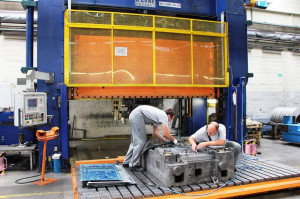 Researcher of Fraunhofer Institute aims to develop industrial machinery with built-in intelligence based on smart self-monitoring functions. New technology developed as part of the iMAIN project provides real-time online monitoring of unprecedented quality to reach a self-maintaining machine.
Researcher of Fraunhofer Institute aims to develop industrial machinery with built-in intelligence based on smart self-monitoring functions. New technology developed as part of the iMAIN project provides real-time online monitoring of unprecedented quality to reach a self-maintaining machine.
As part of the EU-sponsored iMAIN project, the scientists have developed a prototype of an information-based predictive maintenance system that enables operators to determine when a component or entire plant is likely to fail. The distinctive feature of this technology is its use of virtual sensors. These receive input both from computer-simulated models of the machine and from real sensors that provide information on the strain occurring in individual components. “Using mathematical models and a minimum of actually installed, real sensors, it is possible to realistically simulate strain scenarios for the entire machine in real time. This in turn provides the basis for an entirely new and innovative approach to predictive maintenance,” says Markus Wabner of Fraunhofer IWU.
Until now, it has been customary to carry out plant maintenance according to a fixed schedule or on an ad-hoc basis in response to failures. Certain manufacturers already equip their machines with (real) sensors, but solutions that rely exclusively on these devices are not ideal: they are expensive and complicated to implement, require their own error monitoring system, and measure stress and strain only at the points where they are installed — and nowhere else. “In our option, the use of virtual sensors is the only conceivable and economical way to obtain a complete picture of the forces acting on the material,” says Wabner. While algorithms, simulations and mathematical models can often provide a reasonably good image of reality, even the most precise calculations are subject to errors. This is why the researchers constantly compare the virtual data with real measurements recorded while the machine is in operation. “If there is a wide discrepancy between them, we modify the model accordingly,” says Wabner.
A cloud site accessible to internal users via a wide range of interfaces — including smartphones, tablets and laptops — serves as storage of information on the stress history of different manufacturing plants. “The more data we collect, the easier it is to know the right time to implement preventive measures. We develop algorithms that enable machines to learn from experience, and decide on the right time to replace components or determine when they have reached their optimum stress loading. The real data are compared with a simulated model that can be used to calculate the breaking point of the material,” explains Wabner.



